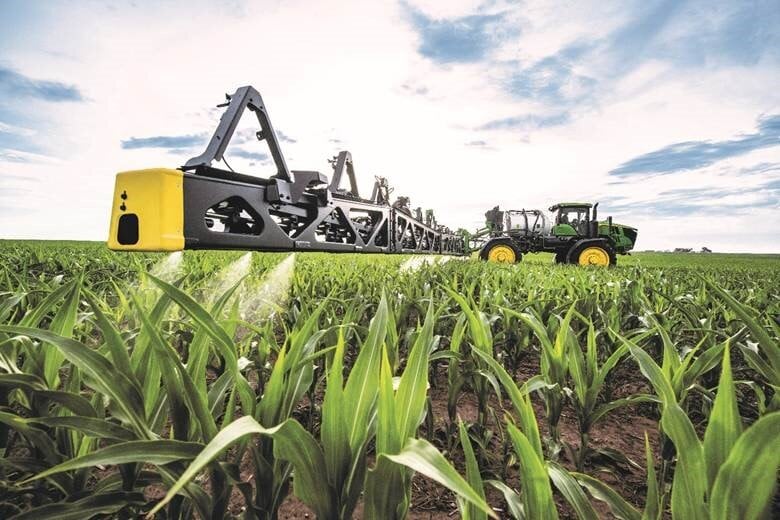Whether you know exactly how you want to use your STEM skills as a FIRST® alum, or you’re still exploring your options, know this: careers that use robotics exist in a wide variety of industries and need to be filled with passionate STEM professionals like YOU! This National Robotics Week, join us as we explore seven unique, robotics-focused career paths at FIRST Strategic Partner companies John Deere, Qualcomm, and RTX.
John Deere

See & Spray photo submitted by John Deere Employee, Logan Briggs, Electrical Systems Engineer and FIRST alum from FIRST® Robotics Competition 171 Cheese Curd Herd in Platteville, Wisconsin.
Electrical Systems Engineer
An Electrical Systems Engineer plays the role of taking high tech electronics using artificial intelligence and designs it into large machinery "robots" that put the tech to work in the field. For example, technology like See & Spray™, which includes 36 cameras and multiple video processing units that basically do "facial recognition" for plants, is incorporated into John Deere's sprayers – essentially turning the sprayer into a giant robot. The engineer helps make sure the technology is seamlessly integrated into the sprayer's design and operates effectively for its many years of life in the field.

John Deere Employee, James Manchuso, Robotics Engineer and FIRST alum with FIRST Robotics Competition Team 2079 “ALARM Robotics.” Now mentor for FIRST Robotics Competition Team 6317 “Disruptive Innovation.”
Robotics Engineer
As part of the manufacturing process, Robotics Engineers help concept, design, and build robotic welding and manufacturing cells used in factories to build John Deere equipment, such as combines and tractors. Software like CAD 3D is used for modeling robotic cell design and system process, which includes everything from end of arm robotic tools, robotic cell safety systems, component fixturing and tooling, along with general manufacturing floor and robotic cell layout.

John Deere Employee, Megan Short, Product Safety Lead: Guidance and Autonomy.
Systems Engineer
When different parts of a robotic subsystem in a tractor work together, planning their behavior is a science. Systems Engineers at John Deere fine-tune systems within our equipment to be able to do things like locate a 40-ton tractor within 2.5 centimeters then drive it at 10 mph to within 5 centimeters of the desired location, even off-road. They also plan and test for unexpected issues to ensure the system remains safe and predictable.
Qualcomm

Sensor fusion and robust positioning for industry.
Systems Engineer - Location Technology (LocTech)
A LocTech engineer works on navigation technology, specifically using Global Navigation Satellite Systems (GNSS), 5G based positioning, and their fusion with sensors like accelerometers, gyroscopes, and camera vision. This work forms the backbone of Qualcomm Technologies solutions for robust positioning, and their chips and positioning algorithms are used in autonomous systems like drones, self-driving cars, smartphones, IoT devices, and more.
RTX

A closer look inside at RTX’s VIIRS sensor.
Software Engineer
RTX’s Visible Infrared Imaging Radiometer Suite (VIIRS) sensor—that rides on a NOAA satellite to gather earth environmental data—is a one-of-a-kind product. RTX doesn’t create robotics or automated systems to build it. VIIRS itself is a robot, of sorts. Software Engineers who write the flight software are coding the sensor to take pictures of the earth autonomously without need of human intervention in an environment where humans could not survive.
Factory Automation Engineer
A Factory Automation Engineer role oversees automation technology design and implementation for the assembly and manufacturing steps in a factory. This role needs to understand the manufacturing process and where to best incorporate automated technologies to improve the process. Although robotics is an important element of this role, a broader system-level understanding of how all these technologies interact and how to control the flow of data to improve manufacturing is a critical success factor to this role.

Ted Niehaus on the Collins Aerospace, an RTX business, Manufacturing Equipment Engineering team in Rockford, Illinois.
Test Equipment Engineer
A Test Equipment Engineer oversees the systems necessary to accurately and repeatedly test products to verify proper fit, form, and function before shipping to the customer. In the case of the North Wind Tunnel project, the Test Equipment Engineer is responsible for designing and incorporating practical automation technologies for the type of air turbine testing being performed. This involves having a broad industry understanding of automation technologies.
From working on navigation technology, writing the flight software for sensors on satellites, and adding automated tech to the farm field, the options to apply your STEM and robotics skills don’t end here. With your FIRST-gained skills, you can get anywhere.
Do you have a cool career in robotics? Share it on social media, tag us, and use #GetAnywhere!
